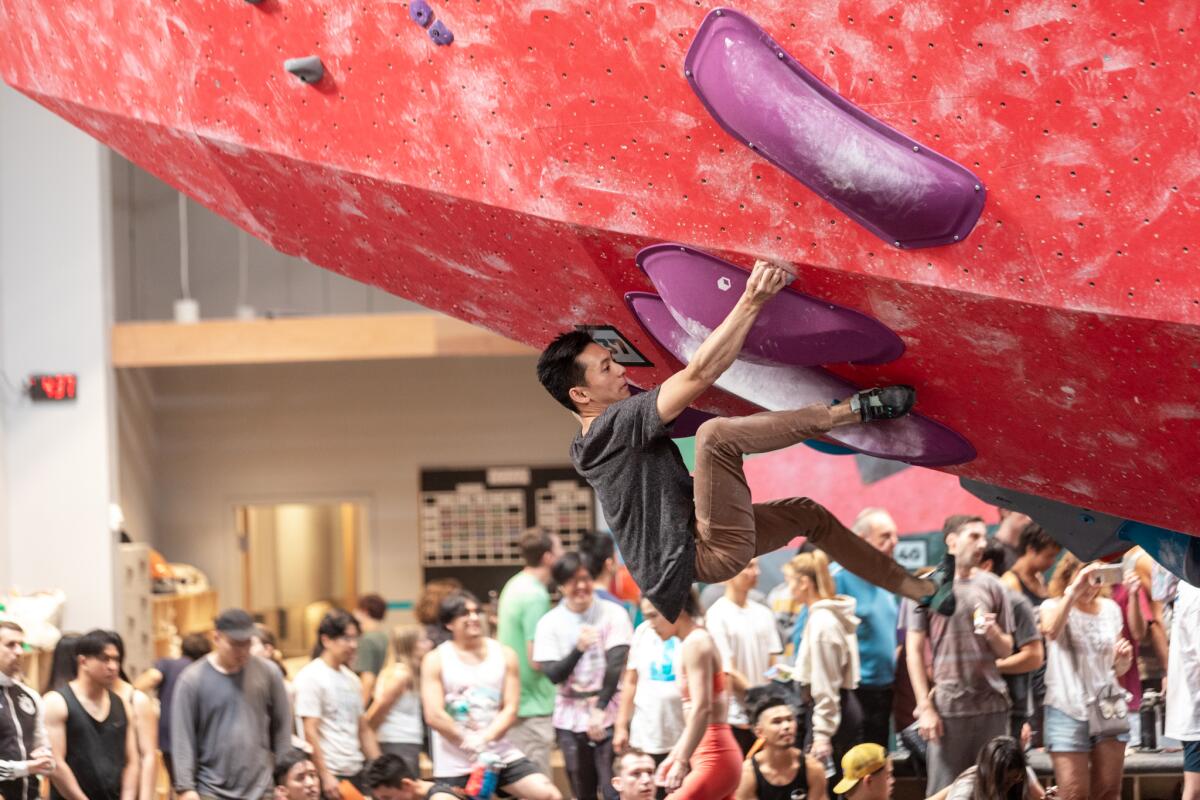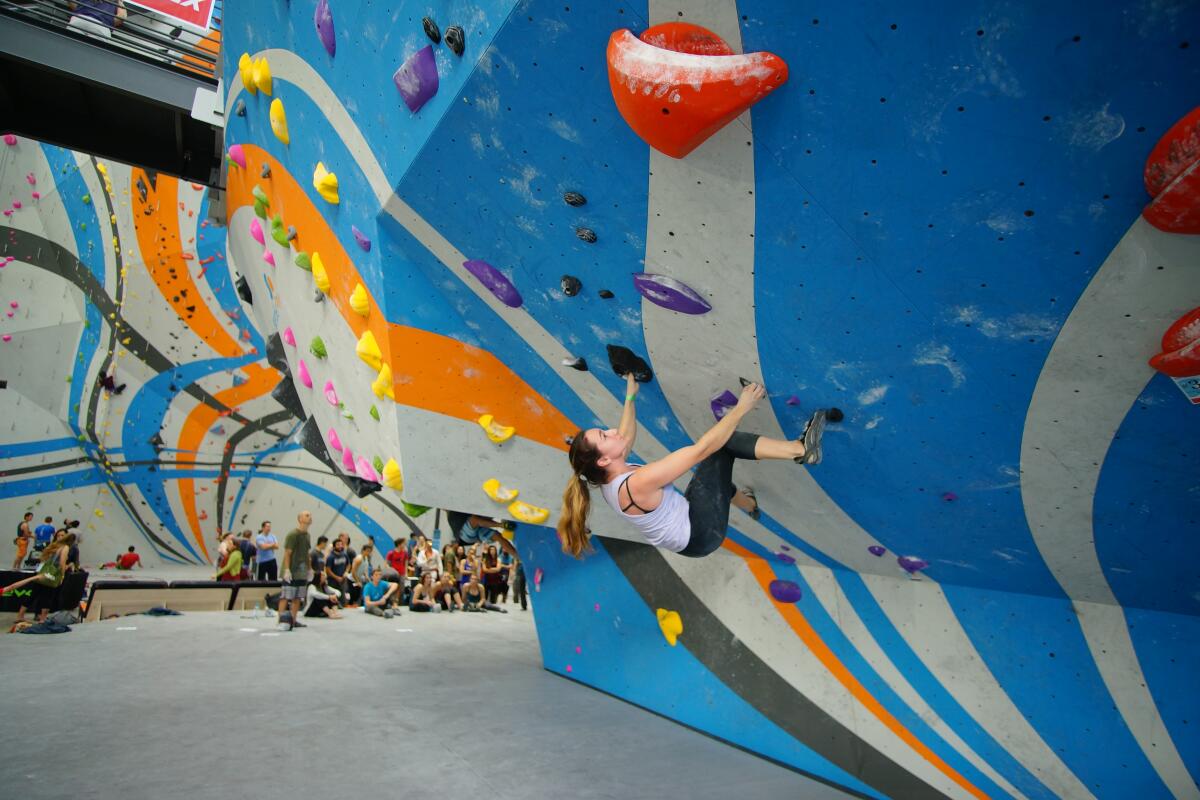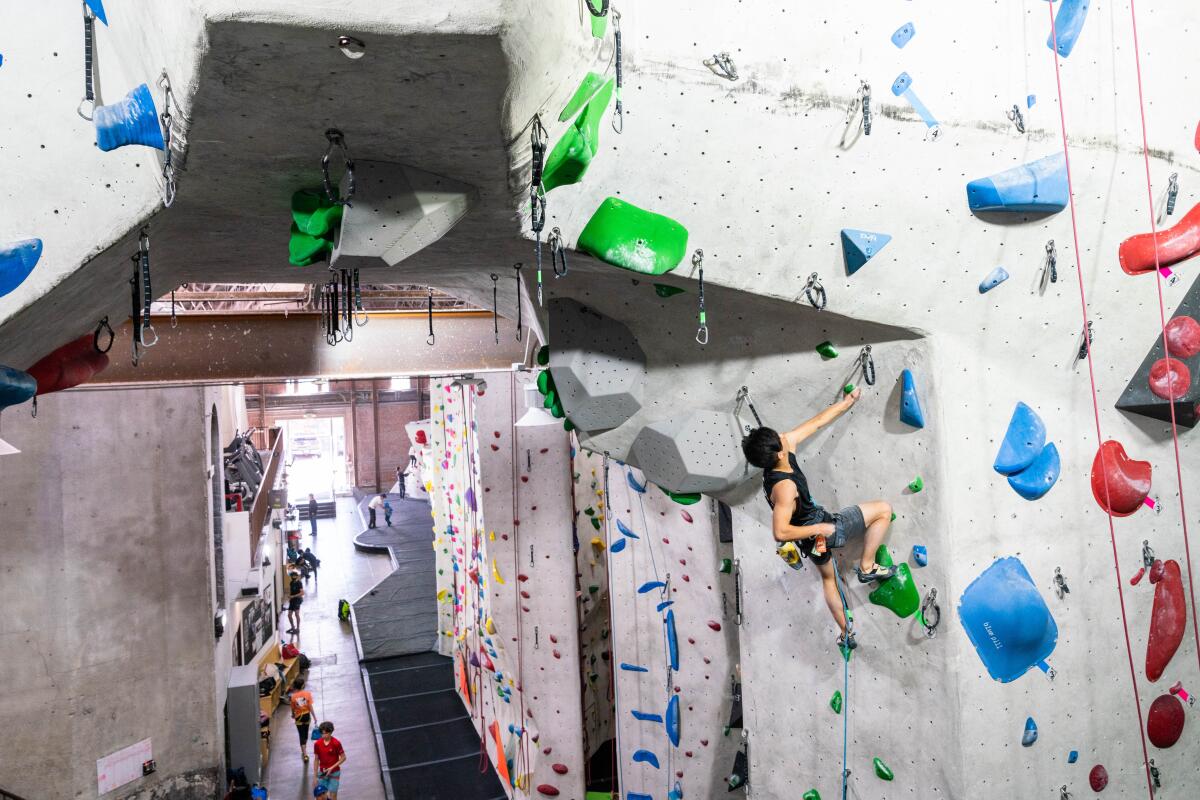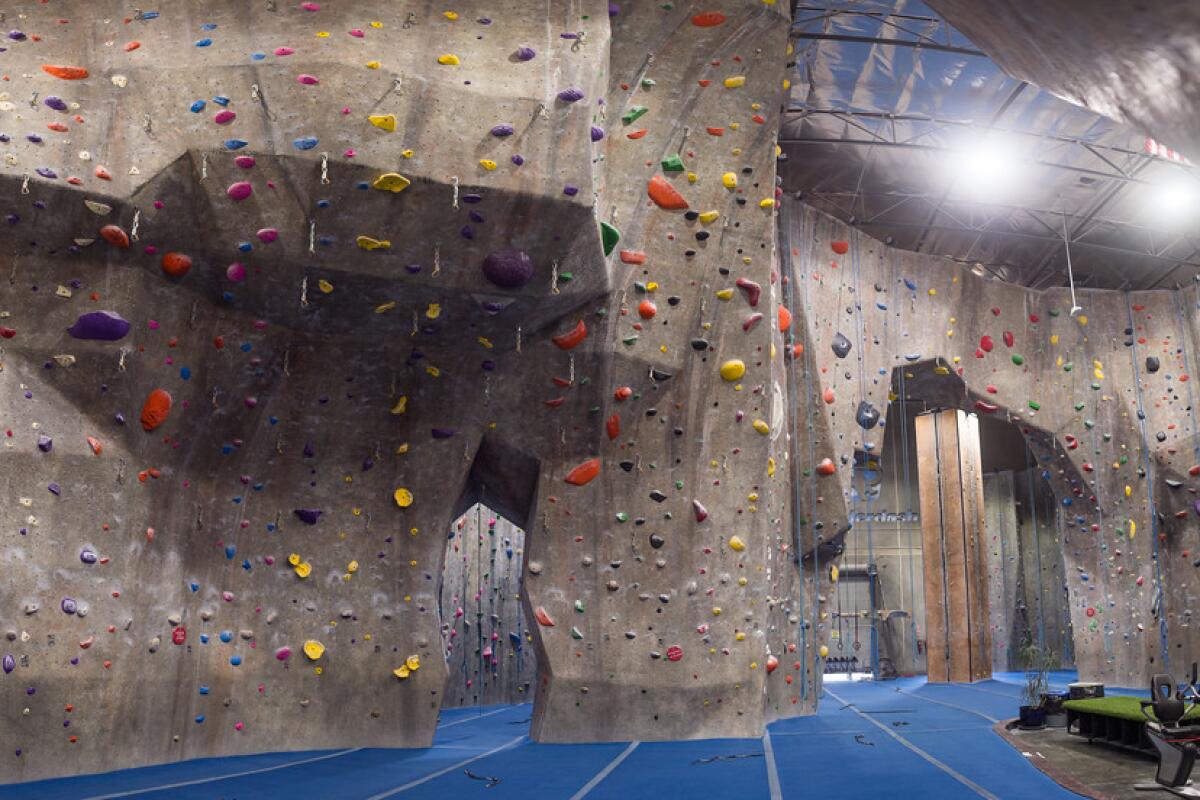
Indoor rock climbing is on fire. These 7 great SoCal gyms let you grab hold of the thrill
- Share via
Attached to a rope 50 feet in the air, you hook your heel onto a tiny ledge above your waist and leverage your body up, your arm muscles quaking as you reach for the ultimate hold. “One more push, and I’ll finish this,” you tell yourself. As you stretch your body and finally reach the top, you exhale, reveling in a moment of sweet success before gliding down to the floor to do it all over again.
In rock climbing, you perform feats you never thought you could, and the fun and feeling of achievement can be addictive. If you’re an old-school L.A. climber, you may remember a time when the city had no indoor climbing gyms. Luckily, that’s changed — climbing has grown steadily over the last five years at a rate of 4% per year, and there are now at least 486 climbing gyms in the U.S.
Training indoors can help prepare you for the mighty challenge of climbing outdoors by strengthening the muscles you’ll need and honing your technique. But indoor climbing has also become an art of its own, with route-setters creating dynamic climbing routes and two-person climbing routes that won’t be found on natural rocks. A gym can be a more accessible option compared to hauling out to Joshua Tree or Tahquitz Peak (especially on hot or rainy days), and it may feel safer for women, queer climbers and climbers of color. Increasingly, rock climbing facilities are also offering elevators and assisted climbing for adaptive climbers.
Along with climbing walls, many gyms provide weight rooms, showers and saunas, supplementary fitness classes like yoga and strength training, climbing technique classes, affinity groups and meetups, kids’ camps and special events for meeting other climbers.
If you don’t have a belay partner (a person who stands on the ground, managing the rope), you can make a public announcement at most gyms over the PA system, or write your name and contact info on a dry-erase board. Or you can look for a gym with an auto-belay system that automatically takes up tension and lowers you. If you’re just getting started, sign up for an intro to climbing or intro to bouldering class to learn the sport.
Here’s where to go indoor rock climbing around Southern California. If you’re ready to get outside instead, read our outdoor climbing guide.
Sender One

Sender offers challenges aplenty, whether you’re interested in competitive training or you just like to climb. Half the gym is dedicated to sport climbing, but you’ll also enjoy two floors of bouldering and an impressive training area with campus boards and interactive climbing boards (you set the route via a phone app, and the holds for your route light up). Members, including kids, can access the Training Center in Santa Ana, a 7,000-square-foot space hosting special events, clinics and competitions. Kids can also join weeklong seasonal climbing camps and competitive teams. Sender hosts a large number of affinity groups, including Black Climbers Union, Send With Pride and ParaSenders.
The cost of entry is steeper at Sender, but you get the luxury you pay for. Day admission costs $32 for adults and $27 for kids 6 to 13, while kids 5 and under are free with a paying adult. Shoe rentals are included in the cost of admission, but harness rentals are $5. You can purchase a $39 intro to climbing class and day pass, which includes rental gear.
The Stronghold Climbing Gym

The Lincoln Heights spot features 10 autobelays, along with 76 top-rope routes and 76 lead routes. New problems and routes with fun names (like “Mr. Burns” and “Calvin Klein” ) are set every week — keep track with this bar graph. You can take unique classes like rappelling here, and perks include a sauna, Pilates, yoga for climbers and a monthly Thai Massage workshop. The gym stays open later than other L.A. climbing gyms, closing at 11 p.m. Monday through Friday.
The Stronghold is housed in a building that was originally California Edison Co.‘s Los Angeles #3 Steam Power Plant. One downside of being in a historic property is that there’s no heating or air conditioning (though the new location coming to Echo Park will have a full HVAC system).
One-time day admission costs $20 for yoga and fitness, and $30 for adults climbing ($25 matinee, which is weekdays before 3 p.m. excepting holidays) and $25 for kids climbing ($20 matinee). ATC belay devices and lead ropes are free, and other gear including harness, shoes and chalk have additional costs. Parking is free, but can be a bit of a challenge on busy evenings after work.
Touchstone Climbing

LA Boulders is more than 12,000 square feet of pure bouldering, with very fun v0, v1 and v2 routes for newbies, as well as intermediate and advanced routes that tackle overhangs and even an arch (see more on this virtual tour). For rope climbing, head to Cliffs of Id and the Post. Grading varies on sport climbs at Touchstone, with the occasional 5.7, 5.8 or 5.9, but most routes center on 5.10 to 5.12, and the route-setters are there every week resetting challenging routes (as well as some very fun problems for bouldering, including partner routes). Amenities vary across the gyms, with saunas, aerobic machines, weights, yoga and fitness classes at every location.
Entry costs $30 on weekdays after 3 p.m. and weekends, and $25 for an early bird pass weekdays before 3 p.m., except holidays. Visitors can show their California EBT or Medi-Cal/BIC cards with their photo ID at the front desk for a $10 Access to Climbing (ATC) Day Pass, which includes free gear rental.
Movement Fountain Valley

New routes are posted by Movement every two weeks on social media like Facebook, and they offer a route-setting apprenticeship program. While most gyms don’t have room for slab, Movement has an entire zone, as well as a protracted overhang to test your mettle.
This is a gym that sets intentions not just for its routes, but for its climbing community. Social impact is a big part of its mission, and the organization donates to a number of nonprofits. They offer bouldering competitions for all levels, like the Friction series. There are after-school programs for ages 6 to 12, and various levels of competitive climbing teams for kids.
Boulderdash

Rope walls stretch to 45 feet, with the emphasis on lead climbing and top roping. The routes vary from beginner up to challenging 5.13 ratings, and the Chatsworth location offers crack climbing, so bring those gloves. For boulderers, the Thousand Oaks location has a traverse over 100 feet long that tests your footwork and positioning, while the Chatsworth location has a 130-foot traverse and top-outs. You’ll get to experience lead climbing a cave roof, which is a unique experience. For diversity’s sake and to mimic more of what you might experience in the outdoors, you’ll get to play with some fun faces here, including long arêtes and slabs. There’s also a rappelling ledge for private lessons.
Kid friendliness is one of Boulderdash’s primary draws, with party packages including a party room, climbing instruction and a staff-member ratio of one to five. Boulderdash is known for its patient instruction by gym staff, whether it’s belaying, top-roping or yoga.
Parking is free, and admission costs $25 per adult, or $20 for 15 and younger. Gear rentals are additional.
Rockreation

“Because we are smaller than a lot of the other gyms, a lot of people meet [here] to go climbing outside,” says Kaitlin Neinstedt, special events manager at Rockreation.
If you spend most of your time ascending, Rockreation has a challenge for you: go sideways and trust your feet and your balance, with 100 feet of continuous traverse bouldering at both its Sawtelle (marked on this map) and Costa Mesa locations. A fun bouldering island mimics some of the feeling of being outdoors on a real boulder, and slab bouldering at the right rear helps you tackle the intimidating skill. For those who prefer sport climbing, there’s top rope, lead and bouldering at both spots, for a total of 10,000 square feet of climbing at Sawtelle and 12,000 square feet of climbing at Costa Mesa. Both locations have arches you can lead-climb.
Rockreation offers an advantage that some might find grueling: hard grading that helps prep climbers for the challenge of the outdoors. Bouldering ratings work differently at Rockreation — there’s a range of ratings per color. “I’m told the grading is a little more difficult than grading at other gyms,” Neinstedt says. “You think you can do a V5, and then you get outside and it’s much harder.”
This community-oriented gym hosts a potluck on the last Thursday of every month. Bring a dish and get a $10 discount off the day pass, which is $25 for adults and $20 for kids under 12. Every Monday and Wednesday, adaptive climbers meet at the Sawtelle location from 6 to 7 p.m. On Wednesdays from 6 to 7 p.m., the location hosts a women’s climb for $15. And in late October, the gym hosts its annual Deadpoint or Die Halloween competition.
Hangar 18
Auto-belay systems make climbing easy — you don’t need a climbing partner to counterbalance and lower you. You’ll find fun overhangs and cave routes at Arcadia, a diverse variety of walls and an interactive board at Long Beach, lead climbing at the South Bay location and exciting routes at Orange.
Hangar 18 gyms are barebones, but if you’re there for the climbing and not the luxuries, this is your spot. You’ll find a training area and yoga room at most locations, but there are no showers or HVAC system at Arcadia, so it can feel hot in the summer and cold in the winter. Parking is easy at most locations, except Orange, where the location in a business complex makes finding a space challenging.
Hangar bills itself as California’s most affordable climbing gym, and that may well be true. Adults 14 and over pay $22 for a one-time day pass, while kids 13 and under cost $18; gear is additional. First-time visitors need to purchase an intro class which includes rental gear and costs $35 for adults, or $30 for kids.



